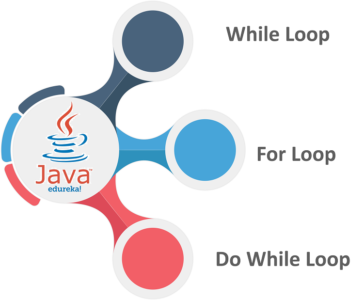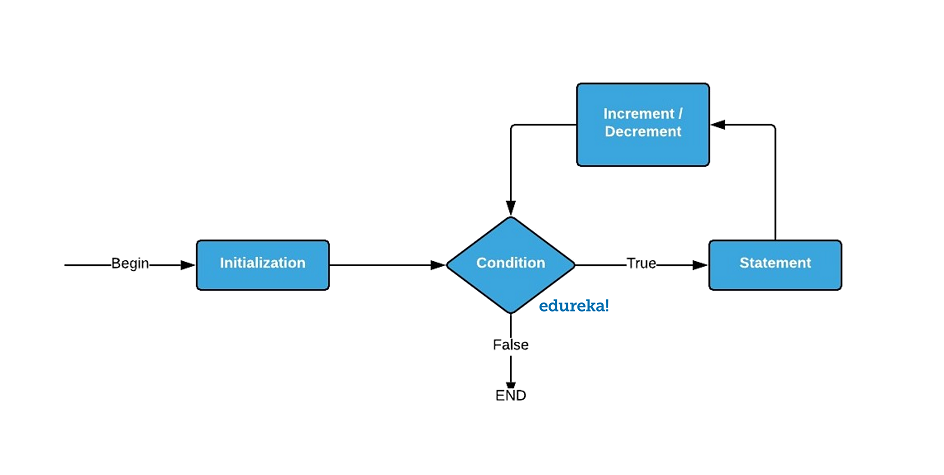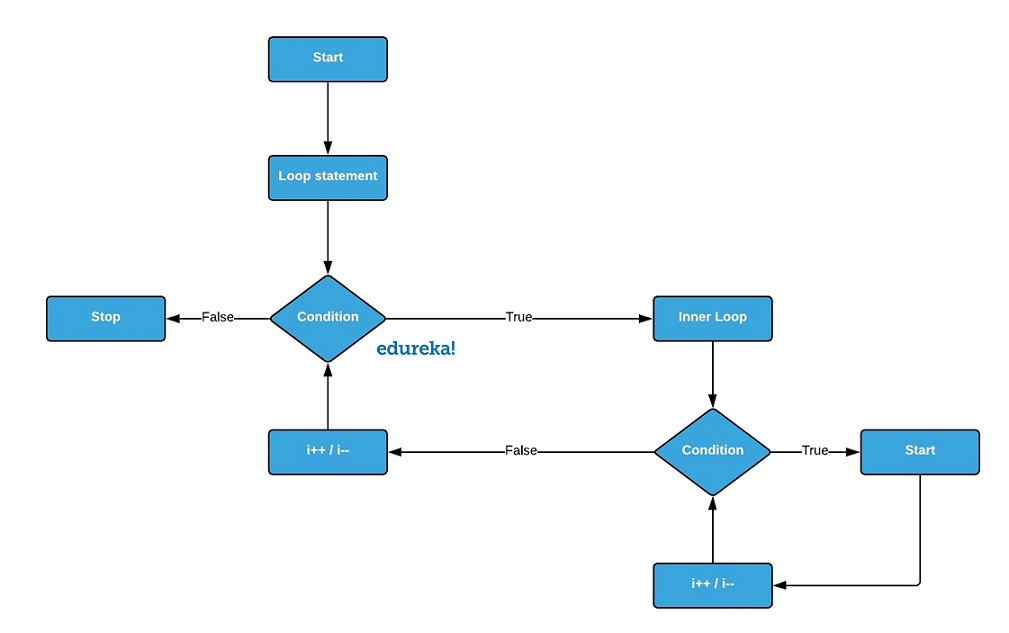Full Stack Development Internship Program
- 29k Enrolled Learners
- Weekend/Weekday
- Live Class
Loops in Java, deliver the interpreter, the ability to make decisions by validating a particular value against a given test condition and execute a particular code segment for a specific number of times until the given condition is satisfied. The Loops in Java are listed as follows:
To understand the terminology of the Conditional Statements and Loops in Java, let us consider the following example.
Mr John would like to buy a brand new car. He likes three colours, namely Black, Red, and Blue. So, his condition to buy a car is that the car must be available in at least one of the three colours.

Let us begin with Conditional Statements in Java. There are basically seven Control Statements in Java as mentioned below:
They suggests the computer that it should carry out the execution of a particular segment of code, given the condition stated is true and valid. The Conditional Statements are classified as shown below
If Condition
If Statement is a programming conditional statement that executes a code segment over a condition, provided if it is true and valid. Below is an example of an If statement.
//Find if the number is positive or negative.
Package ifloop;
public class ifloop {
public static void main(String[] args) {
int number = -10;
if (number > 0) {
System.out.println("Number is positive.");
}
System.out.println("The number is negative.");
}
}
//Output
Discover how to create mobile apps that look and feel great on any platform with a comprehensive Flutter Course.
Else-If Condition
Else If Conditional Statement is used to execute one statement out of the two. The Conditional Statement executes the code segment provided is true and valid. Below is an example of an If statement.
//Find if the number is Even or Odd
package Esleifloop;
import java.util.Scanner;
public class elseifloop {
public static void main(String[] args) {
Scanner kb = new Scanner(System.in);
System.out.println("Enter any integer value");
int a=kb.nextInt();
if(a%2==0){
System.out.println("even number");
}
else{
System.out.println("odd number");
}
}
}
//Output
Enter any integer value21odd number
Example 2
//Find if the Year is a Leap Year or not
package Esleifloop;
import java.util.Scanner;
public class Leapyear {
public static void main(String[] args) {
Scanner kb = new Scanner(System.in);
System.out.println("Enter any year");
int year=kb.nextInt();
if(((year % 4 ==0) && (year % 100 !=0)) || (year % 400==0)){
System.out.println("The Year you have entered is a Leap Year");
}
else{
System.out.println("The Year you have entered is a not Leap Year");
}
}
}
//Output
Enter any year2019The Year you have entered is a not Leap Year
Else-If Ladder
Else if Ladder is set of consecutive Else-If statements which are used to execute one true and valid statement out of a collection of given statements. Below is an example for Else-If Ladder.
//Selecting the Vehicle of your Choice.
package elseifladder;
import java.util.Scanner;
public class ladder {
public static void main(String[] args) {
Scanner kb = new Scanner(System.in);
System.out.println("Enter your chioce, 1 for the Sedan, 2 for SUV, 3 for Sports, 4 Cross Breed");
int choice=kb.nextInt();
if(choice==1){
System.out.println("Sedan Class");
}
else if(choice==2){
System.out.println("SUV Class");
}
else if(choice==3){
System.out.println("Sports Class");
}
else if(choice==4){
System.out.println("Cross-Breed Segment");
}
else {
System.out.println("Invalid Choice");
}
}
}
//Output
Enter your choice, 1 for the Sedan, 2 for SUV, 3 for Sports, 4 Cross-Breed
Nested If Condition
Nested-If is a conditional statement where one Else-If statement is embedded into another If statement. The following program is an example for Nested If condition.
//Find the greatest number out of the given three numbers
package nestedif;
public class nested {
public static void main(String[] args) {
int n1 = 20, n2 = 30, n3 = 10, greatest;
if (n1 >= n2) {
if (n1 >= n3) {
greatest = n1;
}
else {
greatest = n3;
}
}
else {
if (n2 >= n3) {
greatest = n2;
}
else {
greatest = n3;
}
}
System.out.println("Largest number is " + greatest);
}
}
//Output
Ternary Operator
Ternary Operator is a conditional statement which has three arguments. First one is a conditional argument and the second is the result upon a true comparison, and the third is the result upon a false comparison.
//Find the greatest of the two numbers
package Ternary;
import java.util.Scanner;
public class Ternaryoperators {
public static void main(String[] args) {
Scanner kb = new Scanner(System.in);
System.out.println("Enter any integer value to a");
int a=kb.nextInt();
System.out.println("Enter any integer value to b");
int b=kb.nextInt();
int greater = (a < b) ? a : b;
System.out.println(greater);
}
}
//Output
Enter any integer value to a10Enter any integer value to b2525
Switch Statements
Switch Statement is a multi-branch conditional statement. Basically, it has a conditional statement at the beginning of the switch case and the multiple possibilities are included inside the switch case. A case that finds a match is executed else a default statement is executed.
//Find the name of the month by giving an index number.
package Switch;
import java.util.Scanner;
public class switchdemo {
public static void main(String[] args) {
Scanner kb = new Scanner(System.in);
System.out.println("Enter any month");
int month=kb.nextInt();
String name;
switch (month) {
case 1: name = "January";
break;
case 2: name = "February";
break;
case 3: name = "March";
break;
case 4: name = "April";
break;
case 5: name = "May";
break;
case 6: name = "June";
break;
case 7: name = "July";
break;
case 8: name = "August";
break;
case 9: name = "September";
break;
case 10: name = "October";
break;
case 11: name = "November";
break;
case 12: name = "December";
break;
default: name = "Invalid Input";
break;
}
System.out.println(name);
}
}
//Output
Break Statement
Break Statement is a control statement that is used inside a loop to immediately terminate and the program and resume the control at the next statement following in the loop.
//Break the control flow using a break statement
package breakstmt;
public class brkstmt {
public static void main(String args[]) {
int [] integerarray = {10, 20, 30, 40, 50, 60, 70, 80};
for(int num : integerarray ) {
if( num == 40 ) {
break;
}
System.out.print( num );
System.out.print("n");
}
}
}
//Output
102030
Loops in Java are basically divided into three types as described below:

For Loop
For loop is a Control Flow Statement which allows you to execute a specific code segment for a finite number iterations. A for loop has three arguments, namely, initialization variable, Counter variable, and increment/decrement variable.
Below is the flow chart Related to For Loop.
 Following code is an example for For Loop.
Following code is an example for For Loop.
//Print the elements in an array using normal For Loop
package forloop;
public class forloop {
public static void main(String[] args) {
String[] arrData = {"JOHN", "JERRY", "RALPH", "JIM", "TOM"};
System.out.println("Using normal For Loop:");
for(int i=0; i< arrData.length; i++){
System.out.println(arrData[i]);
}
}
}
//Output
Using normal For Loop:JOHNJERRYRALPHJIMTOM
Enhanced For Loop
Enhanced/Advanced For loop is similar to a for loop, but, it minimizes the code length and excludes counter variable and initialization variable. The control flows directly into the array/collection and executes operations on the elements by accessing their index.
Below is the flow chart Related to enhanced For Loop.
 Following code is an example for Enhanced For Loop.
Following code is an example for Enhanced For Loop.
//Print the elements in an array using enhanced/advanced For Loop
package advforloop;
public class advforloop {
public static void main(String[] args) {
String[] arrData = {"JOHN", "JERRY", "RALPH", "JIM", "TOM"};
System.out.println("Using Enhanced For Loop:");
for (String strTemp : arrData){
System.out.println(strTemp);
}
}
}
//Output
Using Enhanced for loop:JOHNJERRYRALPHJIMTOM
Nested For Loop
Nested for loop embeds another For loop within itself. The outer loop triggers the inner loop. The inner loop executes completely and then triggers the outer loop for updating the iteration. This process continues until the outer loop executes completely.
Below is the flow chart Related to Nested For Loop.
 Following code is an example for Nested For Loop.
Following code is an example for Nested For Loop.
//Print the elements in a two dimensional array using normal For Loop
package nestedforloop;
public class nested {
public static void main(String[] args){
int[][] arr = { { 1, 2 }, { 3, 4 } };
for (int i = 0; i < 2; i++)
System.out.println("Row" + i + " - ");
for (int j = 0; j < 2; j++)
System.out.println(arr[i][j]);
}
System.out.println("");
}
}
}
//Output
While loop is a Contol Flow Statement that executes itself repeatedly until a given boolean condition is satisfied. While loop can be considered as a repeating If statement.
Below is the flow chart for While Loop.
 Following code is an example for While Loop.
Following code is an example for While Loop.
//Find if the number is a Prime Number or not using a While Loop
package whileloop;
import java.util.Scanner;
public class whiledemo {
public static void main(String[] args) {
Scanner kb = new Scanner(System.in);
System.out.println("Enter any number");
int num=kb.nextInt();
int i = 2;
boolean flag = false;
while(i <= num/2)
{
if(num % i == 0)
{
flag = true;
break;
}
++i;
}
if (!flag)
System.out.println(num + " is a prime number.");
else
System.out.println(num + " is not a prime number.");
}
}
//Output
Enter any number
5
5 is a prime number.
Do While loop is considered to be a conditional statement completely similar to a normal While loop. The only difference is that the Do While loop has the boolean/conditional statement is placed at the end of the loop. This makes the Do While loop to execute at least for once.
Below is the flow chart for Do While Loop.
 Following code is an example for Do While Loop.
Following code is an example for Do While Loop.
//Insert elements in an array and add them using normal While Loop
package dowhileloop;
import java.util.Scanner;
public class dowhile {
public static void main(String[] args) {
Double a, Summation = 0.0;
Scanner kb = new Scanner(System.in);
do {
System.out.print("Enter a number to perform addition and zero to exit: ");
a = kb.nextDouble();
Summation += a;
}
while (a != 0.0);
System.out.println("Sum of the numbers = " + Summation);
}
}
//Output
Enter a number to perform addition and zero to exit: 10Enter a number to perform addition and zero to exit: 20Enter a number to perform addition and zero to exit: 30Enter a number to perform addition and zero to exit: 40Enter a number to perform addition and zero to exit: 0Sum of the numbers = 100.0
Infinite Loop is not actually a practically designed loop. Instead, It is a situation where the condition of the loop fails and the execution persists until you stop it manually.

Following code is an example for Infinite Loop.
//Generate Infinite Loop
package infiniteloop;
public class infinity {
public static void main(String[] args) {
int i=0;
while(true) {
System.out.println("Edureka");
i++;
}
}
}
//Output
EdurekaEdurekaEdureka.............
With this, we come to an end of this article, I hope you have understood the Loops in Java and their implementation. If you find any queries related to this article, please write them down in the comment section below and we shall revert you back soon.
Now that you have understood basics of Java, check out the Java training by Edureka, a trusted online learning company with a network of more than 250,000 satisfied learners spread across the globe. The course is designed to give you a head start into Java programming and train you for both core and advanced Java concepts along with various Java frameworks like Hibernate & Spring.
 Thank you for registering Join Edureka Meetup community for 100+ Free Webinars each month JOIN MEETUP GROUP
Thank you for registering Join Edureka Meetup community for 100+ Free Webinars each month JOIN MEETUP GROUPedureka.co